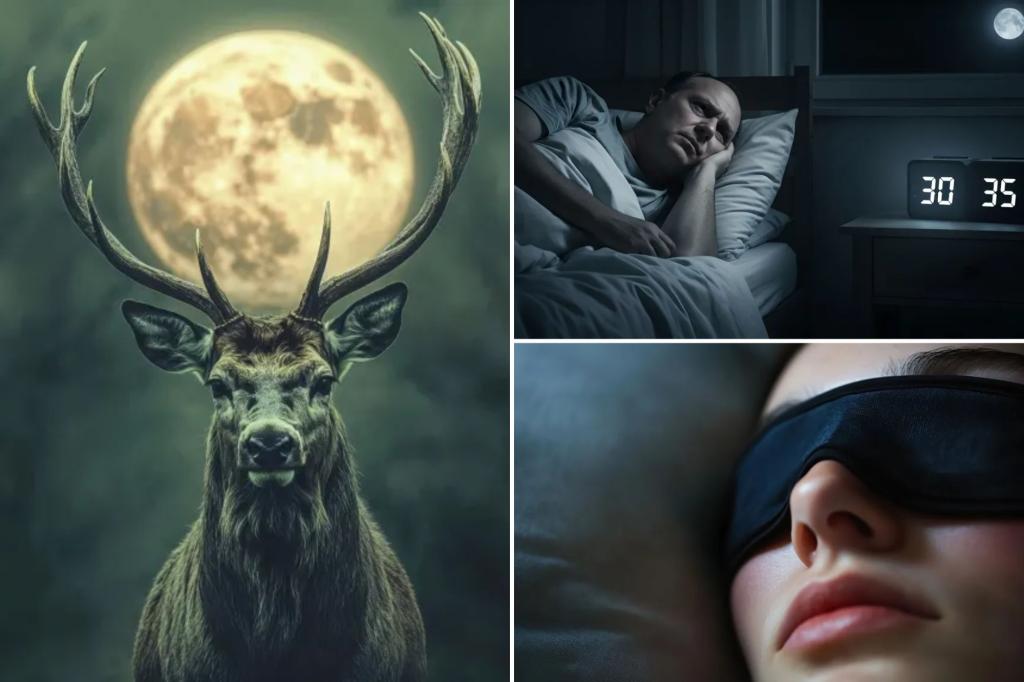A full buck moon is rising and shining this week and wreaking havoc on restful sleep.
The full buck moon peaks at 4:37 PM on Thursday, July 10, 2025.
Experts say July’s full moon could reduce sleep by up to 20 minutes on the evening of the 10th and as much as 90 minutes in the days leading up to and following it.
Scientists in Switzerland previously found that, on the night of the full moon, people take on average five more minutes to fall asleep.
The moon controls the tides, drawing and releasing water to and from the shore. As the human body is 70% water, this same rhythm of rise and fall moves through us.
Full moon July 2025
“If you’ve been struggling to sleep this week or waking up more than usual, the buck moon could be the reason. There’s growing scientific evidence that full moons can interfere with our sleep patterns. It’s not just an old myth. Studies show people tend to take longer to fall asleep, get less deep sleep, and often report feeling more alert than usual during the night,” said Martin Seeley, CEO and sleep expert at MattressNextDay.
Lack of sleep can greatly impact our quality of life. In the long term, it can cause health problems like obesity, depression, poor immune system function, low libido and heart disease, according to the Cleveland Clinic.
Full buck moon
How does the moon pull at our hair and keep us from sleep?
Seeley explains that the brightness of the moon can suppress the body’s production of melatonin, the hormone that signals it’s time for sleep.
“Even a small amount of light can throw off your internal clock. But it’s not just about brightness. Some studies suggest the lunar cycle itself might shift your circadian rhythm or increase nighttime alertness, even in total darkness,” said Seeley.
How to lessen the effects of lunar disruption?
Block out moonlight
To enter deep sleep properly, the body requires total darkness, a goal that’s compromised by the showboat shine of a full moon.
“Even subtle light exposure, such as moonlight slipping through curtains, can disrupt melatonin production,” says Seeley. “Use blackout blinds and eye masks, and block any hallway light.”
Avoid screen time
The full moon compromises circadian rhythm, and exposure to blue light from screens can amplify these effects.
“Replace scrolling with slow breathing, reading, or a calming podcast. The goal is to limit stimulation,” said Seeley.
Establishing a firm cutoff time for tech is a safeguard against habits like doomscrolling — which can impair memory, information retention, and mental health.
Sleep experts also suggest turning off notifications on your phone before you sleep to eliminate disruption or the anticipation of it. This recommendation is echoed by this influencer, who says turning her phone to airplane mode at night helps her sleep and has been a true boon to her mental health.
Lather up with lavender
Full moons tend to make us feel livelier in the evening hours, a restlessness that can be soothed with steam and the sweet scent of lavender.
Lavender has been shown to reduce the activity of the sympathetic nervous system, signaling that it’s safe to wind down.
Also, a hot shower raises the body’s temperature, and when it dips afterward, it mimics the natural drop the body needs to fall asleep.
Keep a consistent bedtime
“The full moon can shift your circadian rhythm, making you feel more awake than usual. But if you keep your sleep and wake times consistent, your body will adjust faster, even if it takes longer to drift off,” explained Seeley.
Experts agree that deep sleep is crucial for the body’s restoration and growth, as it bolsters the immune system, promotes cell regeneration, strengthens muscles and bones, slows brain activity, and lowers blood pressure.
Deep sleep tends to come earlier at night, and the best rest happens between 10 pm and 2 am; thus, an earlier bedtime equals a higher-quality shut-eye.
Try moon breathing
“We always talk about wind-down routines, but few people include breathwork,” said Seeley.
“Moon breathing is a powerful way to create a mental and physical signal that it’s time to rest, especially when sleep feels harder to reach.”
Known in Sanskrit as chandra bhedana pranayama or “moon piercing breath,” the term moon breathing is related to the yogic concept of lunar vs. solar energy.
In this tradition, steady, sedative lunar energy is believed to rest within the left side of the body, while fiery, uplifting energy resides in the right.
In its most basic iteration, moon breathing involves closing off the right nostril and inhaling through the left.
Like other breathing exercises designed to ease us into unconsciousness, moon breathing relies on the connection between breath and the parasympathetic nervous system, which regulates rest and digestion.
Activating the parasympathetic nervous system prompts the body to enter a more relaxed state by lowering blood pressure and slowing the heart rate.
Best deployed in times of stress or sleeplessness, see below for our step-by-step guide to moon breathing.
- Find a comfortable position, either sitting up or lying down.
- Place your thumb underneath your right nostril to close it off.
- Inhale through your left nostril.
- Now either:
- Release your thumb from your right nostril, and exhale through your nose or mouth.
- Exhale through your left nostril.
- Repeat, aiming to breathe steadily, with inhales and exhales of equal length.
- Repeat this action for a few minutes until your breathing is very slow and your body and mind feel at ease.
Astrologer Reda Wigle researches and irreverently reports on planetary configurations and their effect on each zodiac sign. Her horoscopes integrate history, poetry, pop culture, and personal experience. To book a reading, visit her website.
Read the full article here


